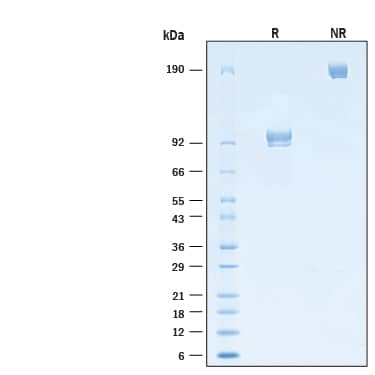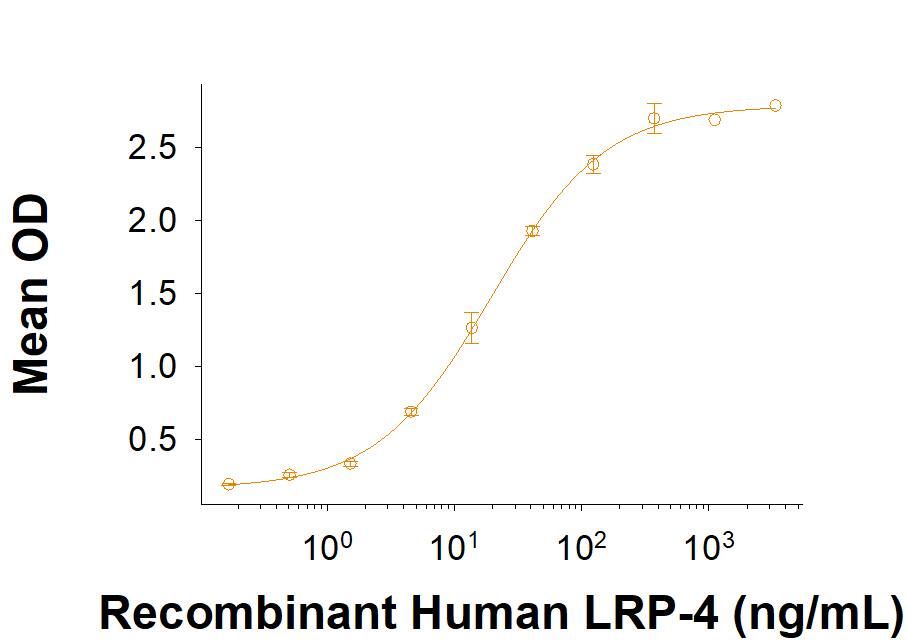Recombinant Cynomolgus Monkey MuSK Fc Chimera Protein, CF
R&D Systems, part of Bio-Techne | Catalog # 11122-MK

Key Product Details
Source
CHO
Structure / Form
Disulfide-linked homodimer.
Biotinylated via Avi-tag.
Biotinylated via Avi-tag.
Conjugate
Unconjugated
Applications
Bioactivity
Product Specifications
Source
Chinese Hamster Ovary cell line, CHO-derived cynomolgus monkey MuSK protein
| Cyno MuSK (Leu24-Thr495) Accession # XP_005581150.1 |
IEGRMD | Human IgG1 (Pro100-Lys330) |
| N-terminus | C-terminus |
Purity
>95%, by SDS-PAGE visualized with Silver Staining and quantitative densitometry by Coomassie® Blue Staining.
Endotoxin Level
<0.10 EU per 1 μg of the protein by the LAL method.
N-terminal Sequence Analysis
Leu24
Predicted Molecular Mass
78 kDa
SDS-PAGE
85-105 kDa, under reducing conditions.
Activity
Measured by its binding ability in a functional ELISA.
In the presence of Recombinant Human Agrin (Catalog # 6624-AG), immobilized Recombinant Cynomolgus Monkey MuSK Fc Chimera (Catalog # 11122-MK) at 0.5 µg/mL (100 µL/well) binds Recombinant Human LRP-4 (Catalog # 5948-LR) with an ED50 of 10.0-80.0 ng/mL.
In the presence of Recombinant Human Agrin (Catalog # 6624-AG), immobilized Recombinant Cynomolgus Monkey MuSK Fc Chimera (Catalog # 11122-MK) at 0.5 µg/mL (100 µL/well) binds Recombinant Human LRP-4 (Catalog # 5948-LR) with an ED50 of 10.0-80.0 ng/mL.
Scientific Data Images for Recombinant Cynomolgus Monkey MuSK Fc Chimera Protein, CF
Recombinant Cynomolgus Monkey MuSK Fc Chimera Protein Binding Activity.
In the presence of Recombinant Human Agrin (6624-AG), immobilized Recombinant Cynomolgus Monkey MuSK Fc Chimera Protein (Catalog # 11122-MK) at 0.5 µg/mL (100 µL/well) binds Recombinant Human LRP-4 (5948-LR) with an ED50 of 10.0-80.0 ng/mL.Recombinant Cynomolgus Monkey MuSK Fc Chimera Protein SDS-PAGE.
2 μg/lane of Recombinant Cynomolgus Monkey MuSK Fc Chimera Protein (Catalog # 11122-MK) was resolved with SDS-PAGE under reducing (R) and non-reducing (NR) conditions and visualized by Coomassie® Blue staining, showing bands at 85-105 kDa and 170-210 kDa, respectively.Formulation, Preparation and Storage
11122-MK
| Formulation | Lyophilized from a 0.2 μm filtered solution in PBS with Trehalose. |
| Reconstitution | Reconstitute at 500 μg/mL in PBS. |
| Shipping | The product is shipped at ambient temperature. Upon receipt, store it immediately at the temperature recommended below. |
| Stability & Storage | Use a manual defrost freezer and avoid repeated freeze-thaw cycles.
|
Background: MuSK
References
- Burden, S.J. et al. (2013) CSH Perspectives Bio. 5(5).
- Hubbard, S.R. and Gnanasambandan, K. (2013) Biochem Biophys Acta. 1834(10):2166.
- Nasrin, F. et al. (2014) Sci. Rep. 4:6841.
- Kuehn, R. et al. (2005) Gene 360:83.
- Camurdanoglu, B.Z. et al. (2016) Sci. Rep. 6:33583.
- Herbst, R. (2020) Neurosci. Lett. (2020) 716:134676.
Long Name
Muscle-specific Receptor Tyrosine Kinase
Alternate Names
EC 2.7.10, EC 2.7.10.1, MGC126323, MGC126324, muscle, skeletal, receptor tyrosine kinase, MuSK, skeletal receptor tyrosine-protein kinase
Gene Symbol
MUSK
Additional MuSK Products
Product Documents for Recombinant Cynomolgus Monkey MuSK Fc Chimera Protein, CF
Product Specific Notices for Recombinant Cynomolgus Monkey MuSK Fc Chimera Protein, CF
For research use only
